2015 年山东青岛大学基础英语考研真题
Part I. Cloze (20 points)
Directions: There are 20 blanks in the following passage. For each blank there are
four choices marked A, B, C and D. You must choose the ONE that best fits into the
passage.
Learning theorists emphasize the role of environmental influences in shaping the
way a person develops.()their view, child development is guided by both deliberate
and ()learning experiences in the home, peer groups, school, and community.
Therefore, childhood growth is significantly() by the efforts of parents, teachers,
and others to () children in desirable ways. According to learning theories, the
same ()that explain how people can use a bicycle or computer also explain how
children acquire social skills, emotional self-control, reasoning strategies, and
the() skills of walking and running.
One kind of learning occurs when a child’s actions are ()by a reward or punishment.
A reward, also called a reinforcer, increases the probability that behavior will
be repeated. For example, a young child may() draw pictures because she receives
praise from her parents after() each one. A punishment decreases the probability
that behavior will be repeated. For example, a child who touches a hot stove and
burns his fingertips is not()to touch the stove again.()kind of learning, classical
conditioning, occurs when a person makes a ()association between two events. For
example, babies begin sucking when they are put in a familiar nursing() , children
fear dogs
whose barking has startled them in the past. A third kind of learning ()of imitating
the behavior of others. A boy may acquire his father’s ()of talking, his mother’
s tendency to roll her eyes, and his favorite basketball player’s moves() the
court. In doing so, he also acquires ()about the consequences of these
behaviors.Learning theories provide extremely useful ways of understanding how
developmental changes in behavior and thinking()and, for some children, why behavior
problems arise. These theories can be studied scientifically and practically applied.
Critics point out,(), that learning theories sometimes neglect children’s ()
role in their own understanding and development.
1. A. With B. From C. For D. In
2. A. unintended B. uninvolved C. undiscovered D. unlimited
3. A. achieved B. created C. developed D. shaped
4. A. moralize B. recognize C. socialize D. standardize
5. A. considerations B. instructions C. principles D. tendencies
6. A. physical B. personal C. original D. technical
7. A. directed B. followed C. pursued D. tracked
8. A. continuously B. immediately C. occasionally D. regularly
9. A. completing B. fulfilling C. handling D. obtaining
10. A. liable B. likely C. possible D. ready
�
11. A. Another B. Next C. One D. Other
12. A. emotional B. intellectual C. mental D. spiritual
13. A. condition B. location C. posture D. situation
14. A. contains B. consists C. comprises D. composes
15. A. custom B. means C. type D. style
16. A. over B. on C. in D. at
17. A. estimations B. evaluations C. explorations D. expectations
18. A. appear B. emerge C. exist D. occur
19. A. accordingly B. however C. moreover D. therefore
20. A. active B. dominant C. positive D. social
Part II. Reading Comprehension (40 points)
Directions: There are three passages in this part. Each passage is followed by some
questions. For each of them there are four choices marked A, B, C and D. Choose the
one that you think is the best answer.
Passage One
Shopping has become a cloak-and-dagger affair. Conspicuous consumption does not look
good during a recession, which explains why so many of us are embracing e-commerce.
Online shopping on these shores is projected to grow from sales of £8.9bn to around
£21.3bn by the end of 2011.
Often people proclaim they’ve embraced e-commerce because it’s “green”.
This is understandable. If many shopping bags in a recession look bad, bricks and
mortar retail --- huge out-of-town shopping centers, retail emporia that insist on
leaving their doors open even in winter and grocery stores full of the most
inefficient freezers --- look terrible during an ecological emergency.
Should we buy the idea that e-commerce is any better? Several studies have tried
to answer this with cold, hard data.
A 2000 study on Webvan, a now defunct US online grocer, concluded that a wider
adoption of e-commerce would not give us environmental gains, while a 2002 study
of US book retailing found no greater energy savings selling online.
But the study that all e-tailers are talking about is a new one from Carnegie Mellon
University, which has found that shopping online via Buy.com’s e-commerce model
for electronic products uses 35 per cent less energy consumption and CO2 emissions
than a traditional bricks-and-mortar model.
This is largely because it avoids the usual retail distribution model and, of course,
the impact of consumers driving to a store (the average person drives 14 miles in
total, to purchase three items).
But both models are flawed, because online or on the street, retailers are dependent
on a hydrocarbon-fuelled delivery system. Trucks deliver 4.8m tons of freight each
day in the UK, which works out at about 80kg per person. To make matters worse, after
a truck drops off the goods it often returns empty to the depot. A 2002 study of
20,000 haulage trips found that only 2.4% of return journey legs found suitable
backloads. This journey represents a large part of the impact of what we buy.
Online shopping may prove marginally more green in terms of energy saving (often
a strategy that favors homogenized, multinational retail), but we shouldn’t forget
�
progressive bricks-and-mortar retail. Places such as Ludlow in Shropshire, a fair
trade town based on ethical trading ideas, where the independent street has been
hard won. It brings consumers face to face with products with an equitable back-story,
shortened supply chain and with values.
This is a wiser and wider retail experience; anything else could leave you feeling
short changed.
21. Which of the following statements is NOT mentioned as the reasons for people’
s embracing e-commerce?
A) Shopping has become a secret affair.
B) Conspicuous consumption does not look good during a recession.
C) E-commerce is “green”.
D) Online shopping is more convenient.
22. What was the result of the 2002 study of US book retailing?
A) There was no greater energy savings selling online.
B) E-commerce would give us environmental gains.
C) Online shopping is projected to grow greatly.
D)Shopping online uses 35 per cent less energy consumption and CO2 emissions than
a traditional bricks-and-mortar model.
23.Which of the following statements can explain the research findings from Carnegie
Mellon University?
A) Online shopping often allows you to avoid compulsive shopping.
B) Online shopping avoids the usual retail distribution model and, of course, the
impact of consumers driving to a store.
C) Only 2.4% of return journey legs found suitable backloads.
D) Online shopping is not dependent on a hydrocarbon-fuelled delivery system.
24. What are the advantages of bricks-and-mortar retail?
A) It brings consumers face to face with products with an equitable back-story,
shortened supply chain and with values.
B) Consumers will never be cheated.
C) The bricks-and-mortar retail model is more suitable for consumers.
D) The bricks-and-mortar retail model uses less energy.
25. What is the author’s attitude towards online shopping and bricks-and-mortar
retail?
A) Online shopping is better than bricks-and-mortar retail.
B) Online shopping may prove marginally greener in terms of energy saving, but the
traditional bricks-and-mortar model also has its advantages.
C) The traditional bricks-and-mortar model is more trustworthy because consumers
can see the products directly.
D) Online shopping will take the place of the traditional bricks-and-mortar model.
Passage Two
How we look and how we appear to others probably worries us more when we are in our
teens or early twenties than at any other time in our life.
Few of us are content to accept ourselves as we are, and few are brave enough to
ignore the trends of fashion.
�
Most fashion magazines or TV advertisements try to persuade us that we should dress
in a certain way or behave in a certain manner. If we do, they tell us, we will be
able to meet new people with confidence and deal with every situation confidently
and without embarrassment. Changing fashion, of course, does not apply just to dress.
A barber today does not cut a boy’s hair in the same way as he used to, and girls
do not make up in the same way as their mothers and grandmothers did. The advertisers
show us the latest fashionable styles and we are constantly under pressure to follow
the fashion in case our friends think we are odd or dull.
What causes fashions to change? Sometimes convenience or practical necessity or just
the fancy of an influential person can establish a fashion. Take hats for example.
In cold climates, early buildings were cold inside, so people wore hats indoors as
well as outside. In recent times, the late President Kennedy caused a depression
in the American hat industry by not wearing hats:
more American men have followed example. There is also a cyclical pattern in fashion.
In the 1920s in Europe and America, short skirts became fashionable. After World
War Ⅱ, they dropped to ankle length. Then they got shorter and shorter until the
miniskirt was in fashion. After a few more years, skirts became longer again.
Today, society is much freer and easier than it used to be. It is no longer necessary
to dress like everyone else. Within reason, you can dress as you like or do your
hair the way you like instead of the way you should because it is the fashion. The
popularity of jeans and the “untidy” look seems to be a reaction against the
increasingly expensive fashions of the top fashion houses.
At the same time, appearance is still important in certain circumstances and then
we must choose our clothes carefully. It would be foolish to go to an interview for
a job in a law firm wearing jeans and a sweater; and it would be discourteous to
visit some distinguished scholar looking as if we were going to the beach or a night
club. However, you need never feel depressed if you don’t look like the latest fashion
photo. Look around you and you’ll see that no one else does either!
26. The author thinks that people are _________.
A) satisfied with their appearance
B) concerned about appearance in old age
C) far from neglecting what is in fashion
D) reluctant to follow the trends in fashion
27. Fashion magazines and TV advertisements seem to link fashion to _________.
A) confidence in life
B) personal dress
C) individual hair style
D) personal future
28. Causes of fashions are _________.
A) uniform
B) varied
C) unknown
D) inexplicable
29. Present-day society is much freer and easier because it emphasizes ____.
�
A) uniformity
B) formality
C) informality
D) individuality
30. Which is the main idea of the last paragraph?
A) Care about appearance in formal situations.
B) Fashion in formal and informal situations.
C) Ignoring appearance in informal situations.
D) Ignoring appearance in all situations.
Passage Three
Since we are social beings, the quality of our lives depends in large measure on
our interpersonal relationships. One strength of the human conditions is our
tendency to give and receive support from one another under stressful circumstances.
Social support consists of the exchange of resources among people based on their
interpersonal ties. Those of us with strong support systems appear better able to
cope with major life changes and daily hassles (困难). People with strong social
ties live longer and have better health than those without such ties. Studies over
a range of illnesses, from depression to heart disease, reveal that the presence
of social support helps people fend off illness, and the absence of such support
makes poor health more likely.
Social support cushions stress in a number of ways. First, friends, relatives, and
co-workers may let us know that they value us. Our self-respect is strengthened when
we feel accepted by others despite our faults and difficulties. Second, other people
often provide us with informational support.
They help us to define and understand our problems and find solutions to them. Third,
we typically find social companionship supportive. Engaging in leisure-time
activities with others helps us to meet our social needs while at the same time
distracting us from our worries and troubles. Finally, other people may give us
instrumental support—financial aid, material resources, and needed services—that
reduces stress by helping us resolve and cope with our problems.
31. Interpersonal relationships are important because _____.
A) they are indispensable to people’s social well-being
B) they awaken people’s desire to exchange resources
C) they help people to cope with life in the information era
D) they can cure a range of illnesses such as heart disease, etc.
32. Research shows that people’s physical and mental health _____.
A) relies on the social welfare systems which support them
B) has much to do with the amount of support they get from others
C) depends on their ability to deal with daily worries and troubles
D) is closely related to their strength for coping with major changes in their lives
33. Which of the following is closest in meaning to the word “cushions” (Para.
2)?
A) Adds up to.
B) Does away with.
�
C) Lessens the effect of.
D) Lays the foundation for.
34. Helping a sick neighbor with some repair work is an example of _____.
A) instrumental support
B) informational support
C) social companionship
D) the strengthening of self-respect
35. Social companionship is beneficial in that _____.
A) it helps strengthen our ties with relatives
B) it enables us to eliminate our faults and mistakes
C) it makes our leisure-time activities more enjoyable
D) it draws our attention away from our worries and troubles
Passage Four
Most of us lead unhealthy lives: we spend far too much time sitting down.
If, in addition, we are careless about our diets, our bodies soon become flabby and
systems sluggish. Then the guilt feelings start: “I must go on a diet. I must try
to lose weight.” “I must get more fresh air and exercise.” “I must stop smoking.”
“I must try to keep fit.” There are some aspects of our unhealthy lives that we
cannot avoid. I am thinking of such features of modem urban life as pollution, noise,
rushed meals and stress. But keeping fit is a way to minimize the effects of these
evils.
The usual suggestion to a person who is looking for a way to keep fit is to take
up some sport or others. While it is true that every weekend you will find people
playing football and tennis in the local park, they are outnumbered a hundred to
one by the people who are simply watching them. It is an illusion to think that you
will get fit by going to watch the football match every
Saturday, unless you count the effort required to fight your way throughout the
crowds to get to the best seats.
For those who do not particularly enjoy competitive sports, it is especially
difficult to do so if you are not good at them. There are such activities for one
person as cycling, walking and swimming. What often happens, though, is that you
do them in such a leisurely way, so slowly, that it is doubtful if you are doing
yourself much good, apart from the fact that you have at least managed
to get up out of your armchair. Of course you can be very thorough about exercise.
Many sports shops now sell frightening pieces of apparatus, chest-expanders and
other mysterious gadgets of shiny spring steel, which, according to the
advertisements, will bring you up to an Olympic standard of fitness, provided that
you follow a regular program of exercises. Such programs generally involve long
periods of time bending these curious bits of metal into improbable shapes.
It all strikes me as utterly boring and time-consuming. Somebody suggested recently
that all such effort was pointless anyway because if you spend half an hour every
day jogging round the local park, you will add to your life exactly the number of
hours that you wasted doing the “jogging” in the first place. The argument is false
even if the facts are correct, but there is no doubt that exercise in itself can
�
be boring.
Even after you have found a routine for keeping in shape, through sport or gymnastics,
you are still only half way to good health, because, according to the experts, you
must also master the art of complete mental physical relaxation. Now, this does not
mean sleeping in the armchair or going dancing (which is a good form of exercise
in itself). It has something to do with deep breathing, emptying your mind of all
thoughts, worries and so on.
36. If you want to keep fit, you should _____.
A) go in for not only competitive sports, but also solitary ones
B) not only go in for sports, but also enjoy your relaxation
C) not put on too much weight
D) not spend long hours sitting in your armchair
37. Which of the following statements is true according to the passage?
A) Life styles of most people are healthy.
B) We can avoid pollution, noise, rushed meals and stress.
C) Keeping fit is not to put on too much weight.
D) Keeping fit is a way to minimize the bad effects of modem urban life.
38. The last sentence of Paragraph 2 suggests that the author thinks ____.
A) fighting your way through crowds is good exercise
B) playing football every Saturday is a good way to keep fit
C) being a spectator is not a way to keep fit
D) few people prefer to play football at the weekends
39. Which statement reflects the author’s point of view on solitary sports?
A) They do not contribute much to your health.
B) They can be done in a slow way.
C) They are boring and time-consuming.
D) They can be done at any time and in any place.
40. Which of the following is NOT mentioned as a way to keep good health in the
article?
A) Mental and physical relaxation.
C) Pieces of exercise apparatus.
B) Competitive and solitary sports.
D) Mountain climbing or fresh-air
breathing.
Part III. Translation (40 points)
Directions:
(1) Translate the following from English into Chinese (20 points)
It is pretty hopeless as a venue of opera, it took 17 years to build, its architect
was forced to resign and it was never properly finished inside. None of this matters.
The Sydney Opera house, by the reclusive Danish architect John Utzon, is the mother
and father of all modern landmark buildings. It has come to define not only a city,
but an entire nation and continent.
Beyond that, it is a global expression of cultural modernity. Everyone in the world
with media access knows what the Sydney Opera House looks like. It is a complete
�
one-off and doesn’t fit into any stylistic or chronological category. Architects
today who try to copy this building always end up looking very second-rate indeed.
It is “modern”, certainly, but it is an expressive modernism that was quite at
odds with the rectilinear “international style” of its time. Of course its location
is an enormous help, sitting as it does on a promontory with water on three sides
and the famous Sydney Harbor Bridge as a picture-postcard backdrop. But Utzon
masterfully exploited the site as nobody else could.
(2) Translate the following from Chinese into English (20 points)
根据卡内基麦伦大学的研究,使用因特网可能会导致心理健康程度的下降。两年的研究表明,
上网次数多的人与较少的人相比,即使是一周仅上网几小时也会经常地感到沮丧和孤独。这
不是说已经有不良感觉的人在网上花费了更多的时间,而是说使用因特网似乎确实诱发了人
们的不良感觉。
研究人员对这些结果困惑不解,因为这与他们的预料截然相反。他们预测,和看电视相比,
从社交角度来说,上网可能更健康一些,因为网络允许使用者选择自己需要的信息并且和别
人进行交流。
研究者推测说,实际情况是上网使网民减少了和家人及朋友共度的时光,这也许可以解释他
们心理健康状况下降的原因。和面对面的交谈相比,这种见不着面、看不见人的“虚”的交
流可能会使人从心理上缺乏满足感。人们通过这种交流结下的友谊也不会太深。还有一种可
能是,网民通过因特网所了解到的广阔的世界使他们对自己的生活不再那么满意了。
Part IV. Writing (50 points)
Topic: Nowadays, people are facing more and more work-related stress. Write an essay
of about 400 words to state the possible reasons for this phenomenon and make some
recommendations about how to solve it.
�
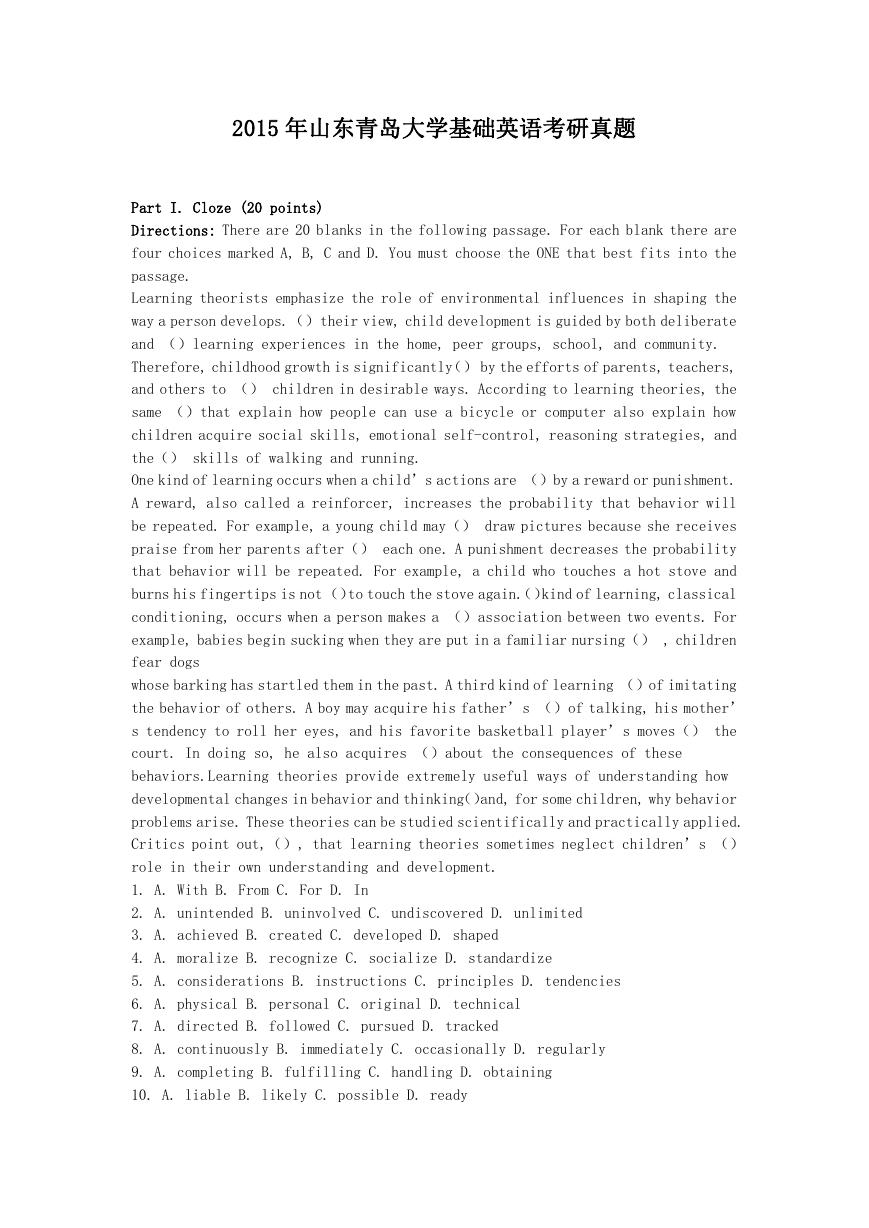
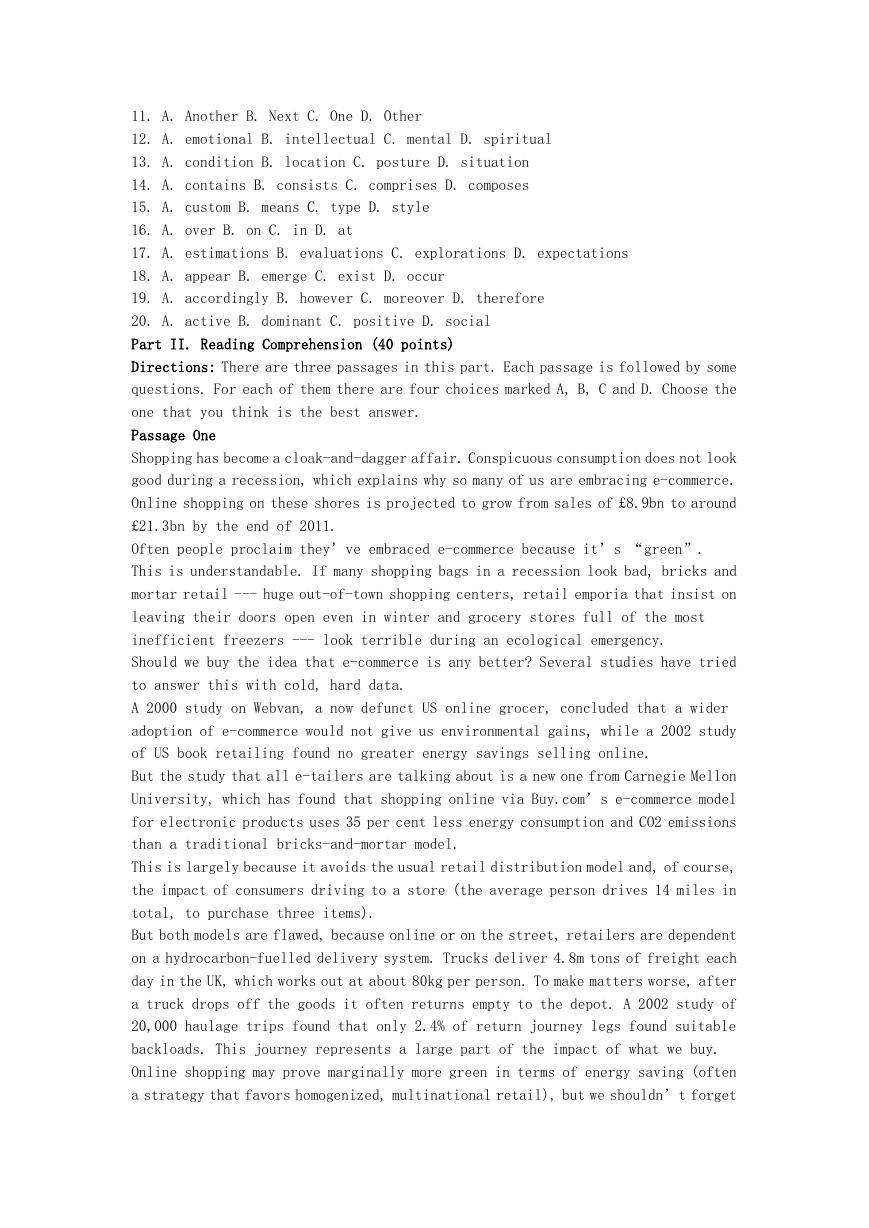
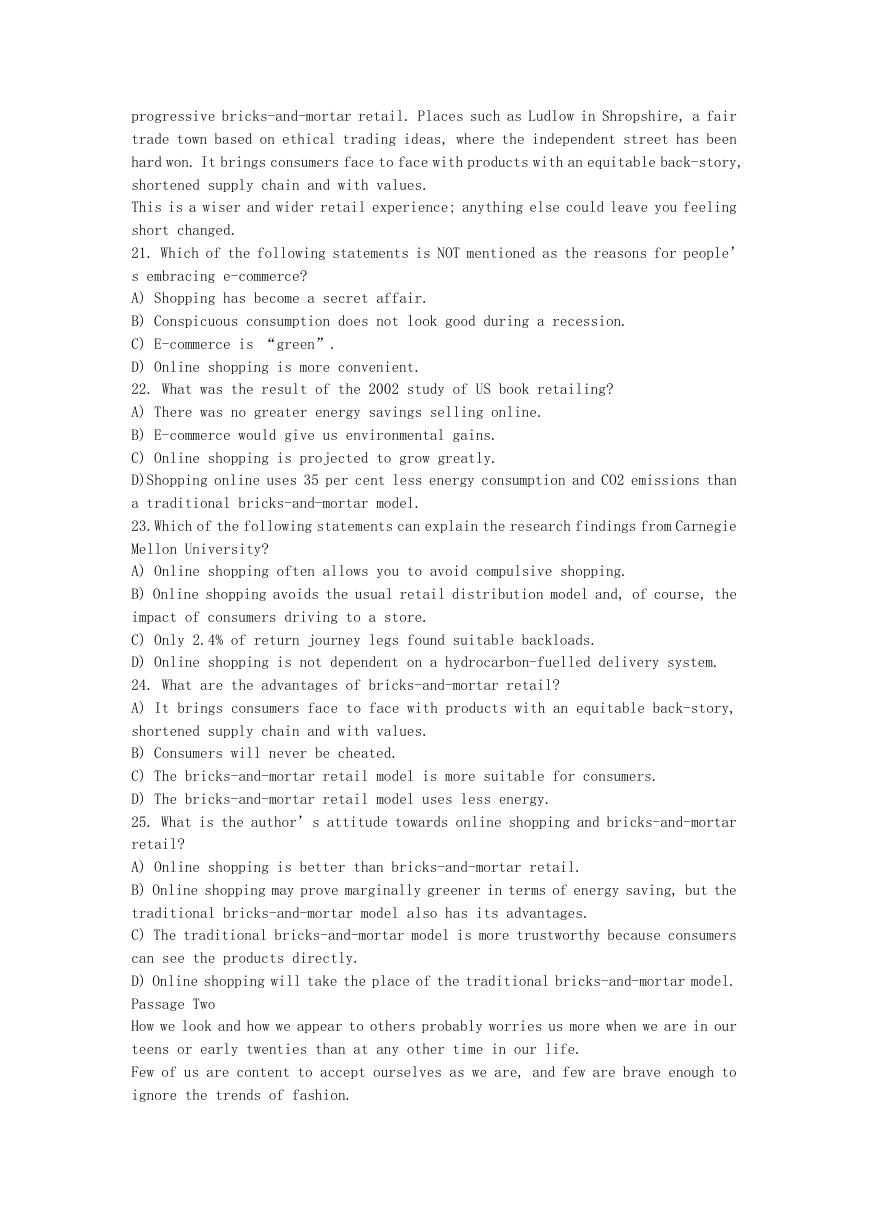
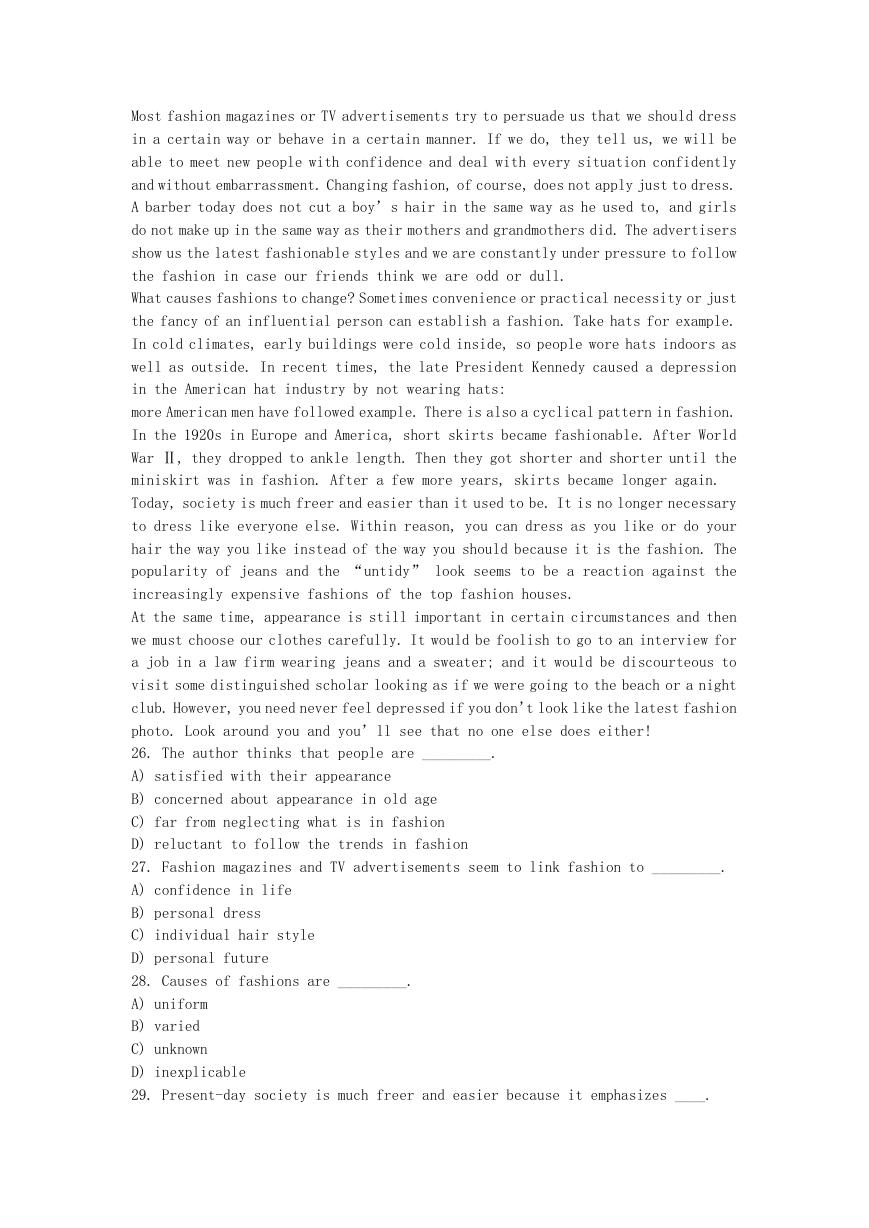
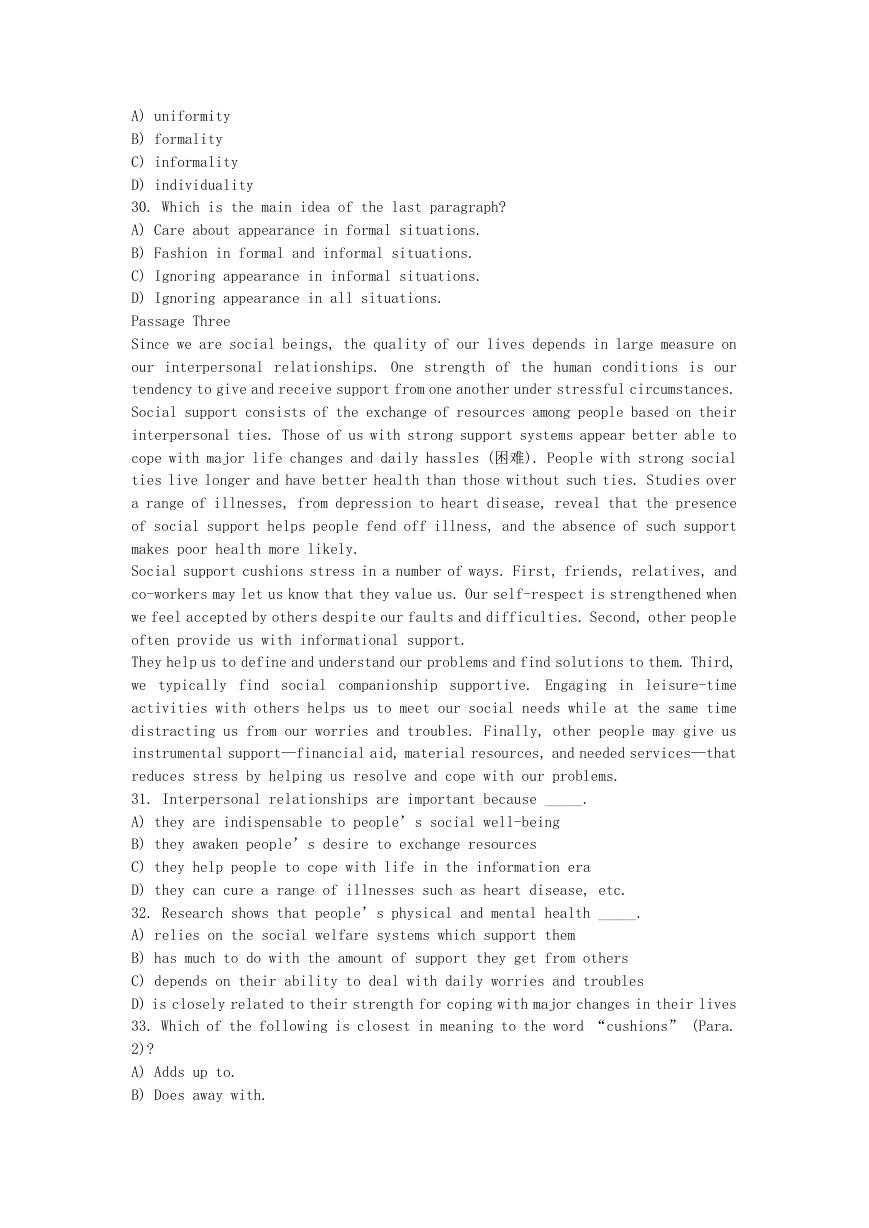
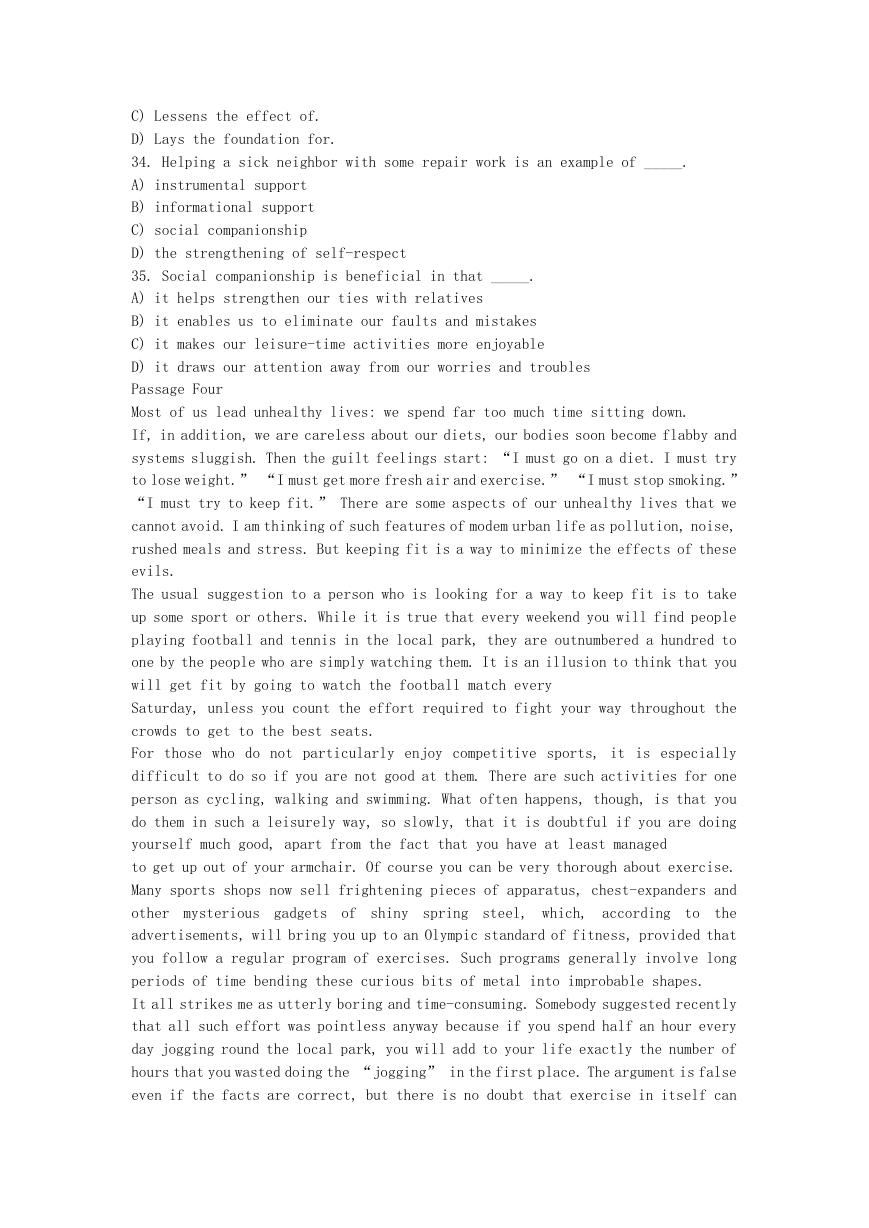
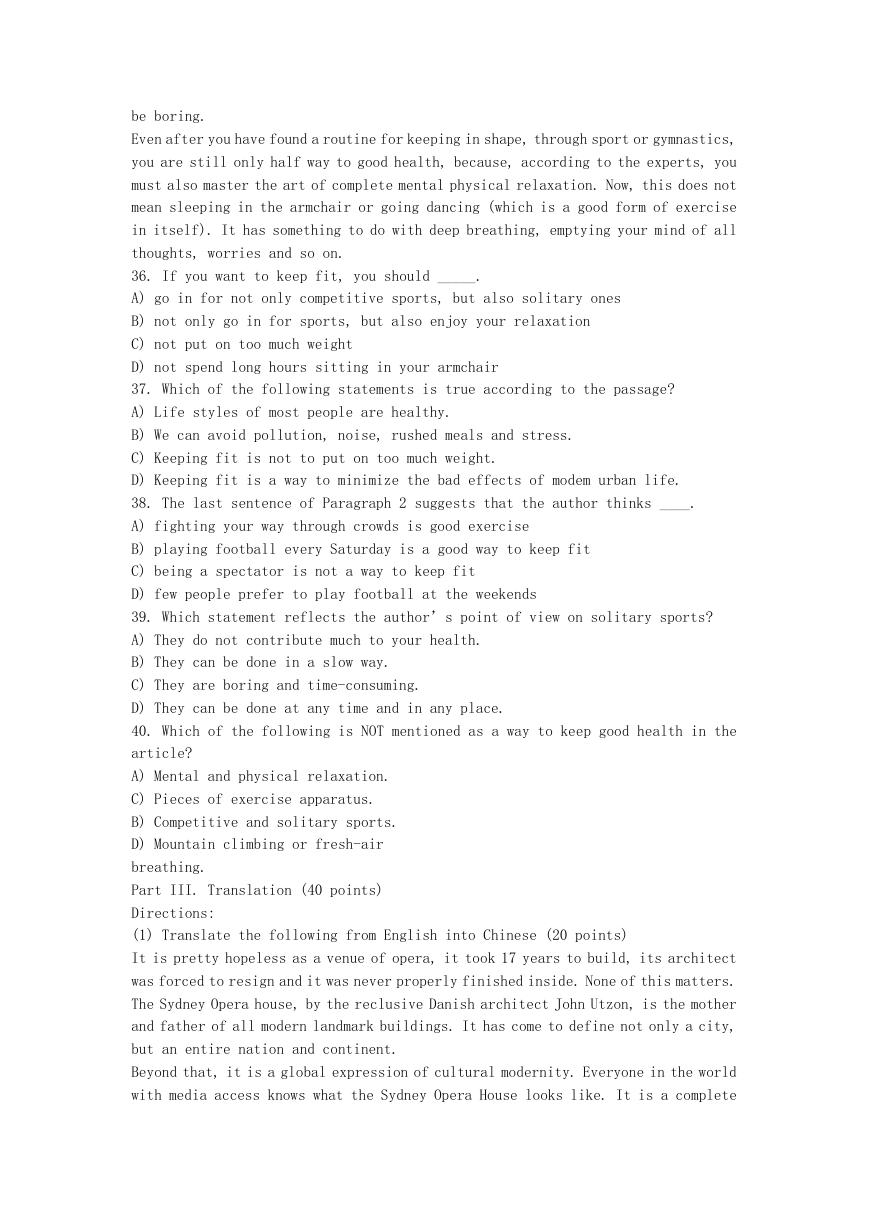
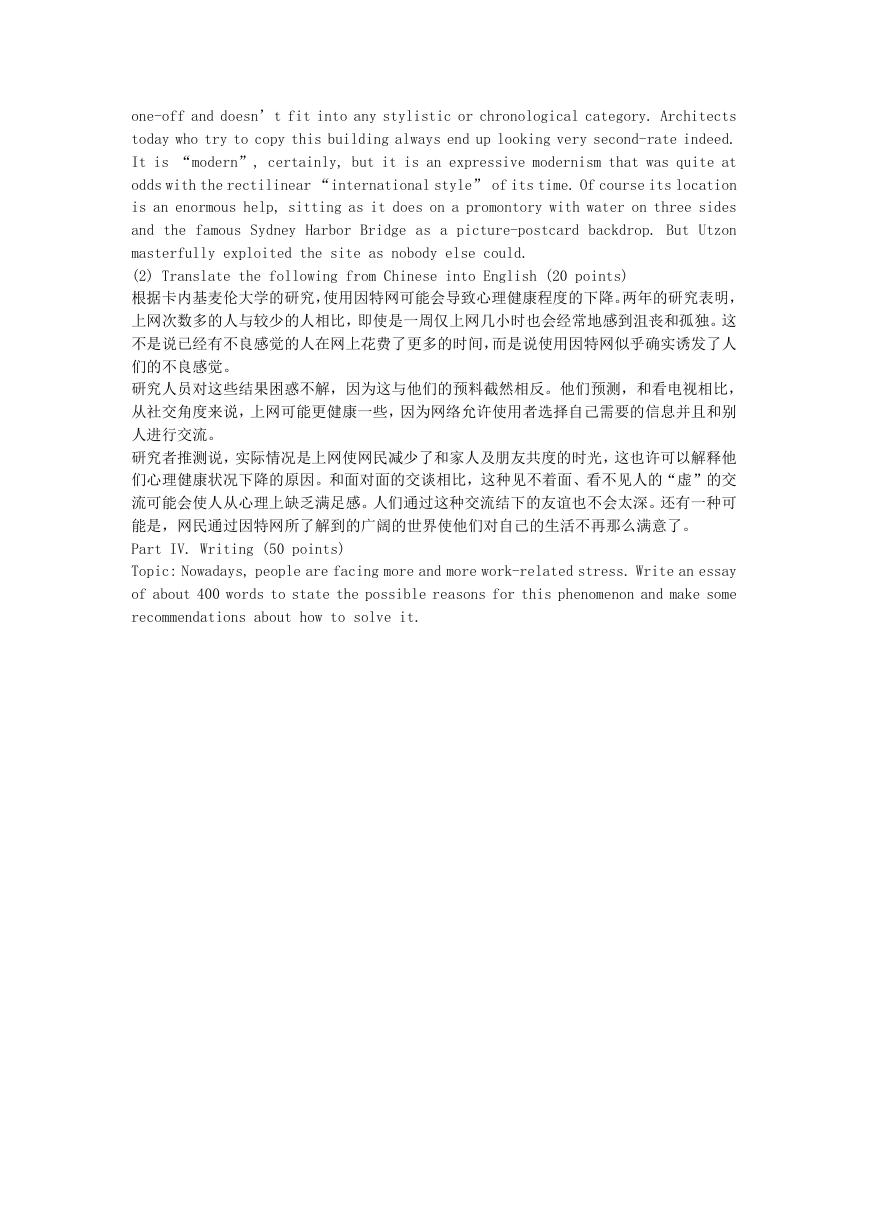








 2023年江西萍乡中考道德与法治真题及答案.doc
2023年江西萍乡中考道德与法治真题及答案.doc 2012年重庆南川中考生物真题及答案.doc
2012年重庆南川中考生物真题及答案.doc 2013年江西师范大学地理学综合及文艺理论基础考研真题.doc
2013年江西师范大学地理学综合及文艺理论基础考研真题.doc 2020年四川甘孜小升初语文真题及答案I卷.doc
2020年四川甘孜小升初语文真题及答案I卷.doc 2020年注册岩土工程师专业基础考试真题及答案.doc
2020年注册岩土工程师专业基础考试真题及答案.doc 2023-2024学年福建省厦门市九年级上学期数学月考试题及答案.doc
2023-2024学年福建省厦门市九年级上学期数学月考试题及答案.doc 2021-2022学年辽宁省沈阳市大东区九年级上学期语文期末试题及答案.doc
2021-2022学年辽宁省沈阳市大东区九年级上学期语文期末试题及答案.doc 2022-2023学年北京东城区初三第一学期物理期末试卷及答案.doc
2022-2023学年北京东城区初三第一学期物理期末试卷及答案.doc 2018上半年江西教师资格初中地理学科知识与教学能力真题及答案.doc
2018上半年江西教师资格初中地理学科知识与教学能力真题及答案.doc 2012年河北国家公务员申论考试真题及答案-省级.doc
2012年河北国家公务员申论考试真题及答案-省级.doc 2020-2021学年江苏省扬州市江都区邵樊片九年级上学期数学第一次质量检测试题及答案.doc
2020-2021学年江苏省扬州市江都区邵樊片九年级上学期数学第一次质量检测试题及答案.doc 2022下半年黑龙江教师资格证中学综合素质真题及答案.doc
2022下半年黑龙江教师资格证中学综合素质真题及答案.doc